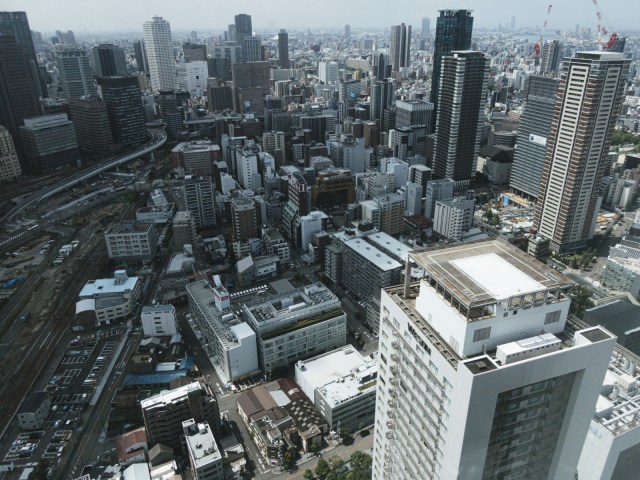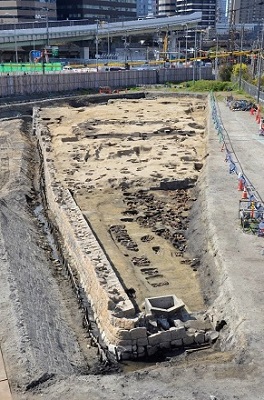
Before the area was known as Umekita, it was known as Umeda Grave.
With people think of a Japanese city with a rich cultural legacy, Kyoto is the first place that springs to mind, but Osaka is no slouch in the historical significance department either. Osaka’s coastal location connected it to trade routes even in Japan’s feudal era, and the town that spread out from Osaka Castle was the country’s most thriving center of merchants and commerce when Tokyo was still a backwater town called Edo.
As present-day Japan’s third-largest city in terms of population, Osaka continues to be a busy place. Right now there’s an urban redevelopment project going on in the area north of Osaka Station, and during construction surveys Osaka’s past, present, and future have intersected.
The district around Osaka Station is called Umeda, and the sub-section where the redevelopment project is taking place is called Umekita (combining “Umeda” and kita/”north”). But once upon a time, it was known as Umeda Haka, or Umeda Grave, one of seven major cemeteries of Osaka. Because of that, survey teams for the Umekita redevelopment project have discovered the bones of more than 1,500 people at a project site, according to a recent announcement from the Osaka CIty Board of Education and Osaka City Cultural Properties Association.
▼ The survey site
Various burial styles were observed, ranging from enclosed wooden caskets to barrel-like open containers, as well as earthenware coffins called kameganbo (“turtle caskets”). While cremation is the norm in Japan now, surveyors found both cremated and non-cremated remains. Several of the bodies had also been interred with burial items such as juzudama (rosary-like prayer beads), rokusenmon (a set of six coins used to pay passage across the Sanzu River, said to separate the world of the living and the afterlife), pipes, and clay dolls.
In another section of the site, separated from the casket area by a stone wall, a mass grave with bodies of the deceased only covered by earth was found. Given the number of people who were apparently buried at the same time, researchers suspect the burial may have come following a plague that claimed the lives of many in a short period of time.
This isn’t the first time for urban development in Osaka to uncover bodies, as a survey in 2017 found the remains of some 200 people. The new discovery, though, is the largest ever for Osaka. Researchers believe that the graves in the newest discovery were those of commoners, not members of the aristocracy, and further study could yield new insights on the lifestyles and burial customs of everyday Japanese people in the late years of the Edo period (1603-1868) and first 20 or so years of the Meiji period (1868-1912), when the cemetery was still in active use.
Sources: Mainichi Shimbun, Osaka City
Top image: Pakutaso
Insert image: Osaka City
● Want to hear about SoraNews24’s latest articles as soon as they’re published? Follow us on Facebook and Twitter!


 Thousands oppose Osaka Metro’s plan to change major stations in giant boats and fabric swatches
Thousands oppose Osaka Metro’s plan to change major stations in giant boats and fabric swatches Upcoming escape game in Osaka pits players against Whity with only a 1% chance of success
Upcoming escape game in Osaka pits players against Whity with only a 1% chance of success Powerful typhoon turns downtown Osaka into a ghost town【Photos】
Powerful typhoon turns downtown Osaka into a ghost town【Photos】 Survey ranks the most desirable neighborhoods to live in Japan’s Kansai region
Survey ranks the most desirable neighborhoods to live in Japan’s Kansai region There’s a samurai-era village for you to walk through at this awesome overlooked museum in Japan
There’s a samurai-era village for you to walk through at this awesome overlooked museum in Japan Japan’s new difficult-to-drink-from beer glass protects your liver, but it’s a brutal experience
Japan’s new difficult-to-drink-from beer glass protects your liver, but it’s a brutal experience How to order snacks on a Shinkansen bullet train in Japan
How to order snacks on a Shinkansen bullet train in Japan New samurai glasses are Japan’s latest weird must-have souvenir
New samurai glasses are Japan’s latest weird must-have souvenir “Deflowering” services for virgin women are now a thing in Japan, apparently
“Deflowering” services for virgin women are now a thing in Japan, apparently Doraemon found buried at sea as scene from 1993 anime becomes real life【Photos】
Doraemon found buried at sea as scene from 1993 anime becomes real life【Photos】 Burger King Japan suddenly adds Dr. Pepper and Dr. Pepper floats to its menu nationwide
Burger King Japan suddenly adds Dr. Pepper and Dr. Pepper floats to its menu nationwide Hello, cosmetics! Clinique teams up with Hello Kitty this summer for first-time collaboration
Hello, cosmetics! Clinique teams up with Hello Kitty this summer for first-time collaboration Princesses, fruits, and blacksmiths: Study reveals the 30 most unusual family names in Japan
Princesses, fruits, and blacksmiths: Study reveals the 30 most unusual family names in Japan High-fashion Totoro cuddle purse is like an elegant stroll in the forest【Photos】
High-fashion Totoro cuddle purse is like an elegant stroll in the forest【Photos】 Demon Slayer: Kimetsu no Yaiba gets new roller coaster attractions and food at Universal Studios Japan
Demon Slayer: Kimetsu no Yaiba gets new roller coaster attractions and food at Universal Studios Japan Nintendo history you can feel – Super NES, N64, and GameCube controllers become capsule toys
Nintendo history you can feel – Super NES, N64, and GameCube controllers become capsule toys “The most Delicious Cup Noodle in history” – Japan’s French Cup Noodle wins our heart【Taste test】
“The most Delicious Cup Noodle in history” – Japan’s French Cup Noodle wins our heart【Taste test】 Starbucks releases a cute Frappuccino and Unicorn Cake…but not in Japan
Starbucks releases a cute Frappuccino and Unicorn Cake…but not in Japan Kyoto Tower mascot termination reveals dark side behind cute Japanese characters
Kyoto Tower mascot termination reveals dark side behind cute Japanese characters McDonald’s Japan’s Soft Twist Tower: A phantom ice cream only sold at select branches
McDonald’s Japan’s Soft Twist Tower: A phantom ice cream only sold at select branches Yabai Ramen: What makes this Japanese ramen so dangerous?
Yabai Ramen: What makes this Japanese ramen so dangerous? Finally! Nintendo Japan expands Switch 8-bit controller sales to everybody, Online member or not
Finally! Nintendo Japan expands Switch 8-bit controller sales to everybody, Online member or not Japanese government wants to build luxury resorts in all national parks for foreign tourists
Japanese government wants to build luxury resorts in all national parks for foreign tourists To combat declining birth rate, Japan to begin offering “Breeding Visas” to foreigners
To combat declining birth rate, Japan to begin offering “Breeding Visas” to foreigners 10 things you should buy at 7-Eleven in Japan
10 things you should buy at 7-Eleven in Japan Studio Ghibli releases anime heroine cosplay dresses that are super comfy to wear
Studio Ghibli releases anime heroine cosplay dresses that are super comfy to wear Woman charged for driving suitcase without a license in Osaka
Woman charged for driving suitcase without a license in Osaka Studio Ghibli unveils My Neighbour Totoro miniature house model
Studio Ghibli unveils My Neighbour Totoro miniature house model Kyoto experiencing problems with foreign tourists not paying for bus fares, but not on purpose
Kyoto experiencing problems with foreign tourists not paying for bus fares, but not on purpose Fighting mild hunger with a Japanese soda that turns into jelly in the stomach【Taste test】
Fighting mild hunger with a Japanese soda that turns into jelly in the stomach【Taste test】 Studio Ghibli’s Howl’s Moving Castle tapestry unveiled in Japan for first time
Studio Ghibli’s Howl’s Moving Castle tapestry unveiled in Japan for first time McDonald’s new Happy Meals offer up cute and practical Sanrio lifestyle goods
McDonald’s new Happy Meals offer up cute and practical Sanrio lifestyle goods Sales of Japan’s most convenient train ticket/shopping payment cards suspended indefinitely
Sales of Japan’s most convenient train ticket/shopping payment cards suspended indefinitely Sold-out Studio Ghibli desktop humidifiers are back so Totoro can help you through the dry season
Sold-out Studio Ghibli desktop humidifiers are back so Totoro can help you through the dry season Japanese government to make first change to romanization spelling rules since the 1950s
Japanese government to make first change to romanization spelling rules since the 1950s Foreigner’s request for help in Tokyo makes us sad for the state of society
Foreigner’s request for help in Tokyo makes us sad for the state of society Ghibli founders Toshio Suzuki and Hayao Miyazaki contribute to Japanese whisky Totoro label design
Ghibli founders Toshio Suzuki and Hayao Miyazaki contribute to Japanese whisky Totoro label design Tokyo’s most famous Starbucks is closed
Tokyo’s most famous Starbucks is closed Survey asks Japanese people where they’d most like to “live” after death
Survey asks Japanese people where they’d most like to “live” after death Pet crematorium in Japan was burning trash with animals for more than 10 years
Pet crematorium in Japan was burning trash with animals for more than 10 years Shibuya Station 2019: one step closer to the Neo-Tokyo of our dreams
Shibuya Station 2019: one step closer to the Neo-Tokyo of our dreams Here’s a little tip from a Buddhist monk for anyone spooked by cemeteries at night
Here’s a little tip from a Buddhist monk for anyone spooked by cemeteries at night Undetonated one-ton U.S. bomb found near downtown Osaka
Undetonated one-ton U.S. bomb found near downtown Osaka Osaka Metro to test stores where you can pay with your face, even with a mask
Osaka Metro to test stores where you can pay with your face, even with a mask Luxury hotel chain opens hotel on edge of Osaka’s infamous Nishinari for its “deep culture”
Luxury hotel chain opens hotel on edge of Osaka’s infamous Nishinari for its “deep culture” Which Japanese prefecture buys the most leopard print clothes?
Which Japanese prefecture buys the most leopard print clothes? Taco Bell Osaka branches now selling okonomiyaki burritos, promise delicious fusion flavor
Taco Bell Osaka branches now selling okonomiyaki burritos, promise delicious fusion flavor Is roughly half of Japan preconditioned to hate mint chocolate sweets?
Is roughly half of Japan preconditioned to hate mint chocolate sweets? Brand-new Nintendo shop announced for Osaka
Brand-new Nintendo shop announced for Osaka Osaka World Expo “Fist” statue stirs controversy for being “incredibly gaudy”
Osaka World Expo “Fist” statue stirs controversy for being “incredibly gaudy” Everything you need to know about takoyaki (octopus balls) 【Video】
Everything you need to know about takoyaki (octopus balls) 【Video】 Green tea ice cream from Nara combines everything we love about the city into one cute dessert
Green tea ice cream from Nara combines everything we love about the city into one cute dessert Three main reasons why fewer and fewer Japanese people are having funerals
Three main reasons why fewer and fewer Japanese people are having funerals
Leave a Reply